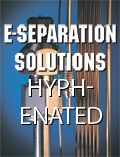The Next Wave of Hyphenated Techniques
What are the latest trends in hyphenated techniques and what benefits do they offer? We asked Ian Jardine, Thermo Fisher Scientific; Massimo Santoro, Perkin Elmer; and Jürgen Wendt, Leco.

Liquid chromatography (LC) and gas chromatography (GC) techniques hyphenated to mass spectrometry (MS) have become a popular and valuable tool in the analytical chemist’s arsenal. What are the latest trends in hyphenated techniques and what benefits do they offer the chromatographer in practice? We spoke to Ian Jardine of Thermo Fisher Scientific, Massimo Santoro of PerkinElmer, and Jürgen Wendt of Leco to find out more.
What are the most exciting developments in using MS as a hyphenation technique at the moment?
Jardine:MS and MS–MS continue to advance with faster scan speeds (to keep up with faster ultrahigh-pressure liquid chromatography [UHPLC]); better sensitivity; higher dynamic range; much higher mass resolutions (> 50,000) with associated higher routine mass accuracies (~1ppm) and new simultaneous combinations of qualitative analysis (accurate identification) and high precision quantitation. Because the MS data is now so good, a single run can often capture a complete MS and MS–MS map of a chromatographed sample, which can then be re-interrogated at some future time for previously unidentified components without having to rerun the sample.
Santoro: Interfacing mass spectrometry with chromatography is becoming less critical in some quality control assays. The advent of direct sampling analysis MS ion sources is providing the opportunity to minimize sample preparation — or to deal directly with samples with no preparation at all.
This allows the analyst to run many samples in an hour and eliminate the formation of artifacts. We will see, in the future, a large growth of this no-sample-preparation analytical approach coupled with mass spectrometry as a detection tool.
Another expanding area of interest is linking MS capability with gas chromatography, infrared, and thermogravimetric analysis in a single system offering increased sensitivity and detection capability.
Wendt: Analytical labs face the pressure of increasing productivity combined with the demand of improved MS data quality. New instrument developments in LC–MS and GC–MS are meeting these demands. Time-of-flight- mass spectrometry (TOF–MS) systems with high resolution power, excellent mass accuracy and stability combined with fast acquisition rates can address these challenges.
High-resolution TOF technology also fits perfectly well with contemporary separation techniques, such as UHPLC and ultrafast GC, which allows the analysis of targets, suspects, and unknowns in one analytical run.
Exciting MS developments also need powerful, flexible, and easy-to-use software packages for data processing, spectral interpretation, and report generation. As well as hardware and software improvements the trend to offer a complete solution, which involves a sample preparation protocol, a robust and reliable LC– and GC–MS method, and an automated data processing step, will continue in many markets, such as food safety, environmental, forensics, and clinical.
What are the biggest challenges facing chromatographers using MS as a detector — and how do they overcome them?
Jardine: Recognizing and trouble-shooting the chromatograph and column is now often more taxing than the MS system, which tend to be automated, including easy calibration. Intuitive software for the chromatographer to handle and analyze the often voluminous amounts of MS and MS–MS data generated is an ongoing problem, especially as new MS techniques are introduced. For example, electron transfer dissociation (ETD) for large peptide fragmentation. The chromatographer is usually dependent on the MS provider to advance software as quickly as possible, but they can help by expressing specific needs to manufacturers.
Santoro: Modern GC–MS and LC–MS instrumentation generates a lot of data, very quickly. The critical factor is making sure the right software tools are in place to mine data to interface with external databases, and provide a smooth and intuitive workflow for qualitative and quantitative analysis.
Wendt: The need for the low-level detection of analytes in complex matrices is becoming essential. GC–MS, techniques to overcome this requirement involve comprehensive GC (GCxGC), GC–MS-MS and GC–high resolution. For LC analysts UHPLC–MS–MS and UHPLC-high resolution are becoming important.
As well as target analytes, it is very useful if suspects and unknowns can be identified in one analytical run. For both GC–MS and LC–MS there is a significant advantage of TOF systems to perform both screening and target analysis in a single run.
Automating data generation and interpretation makes the analysts life much easier. Easy-to-operate, robust hardware with intuitive software packages for data processing and interpretation, which fits in the workflow of the laboratory are very useful for the analyst.
Are there any new areas that chromatography–mass spectrometry is becoming more popular in?
Jardine: Protein chromatographic separation with direct "top-down" MS–MS fragmentation for structural determination, especially for modified proteins, such as glycosylation and phosphorylation in biopharma products, is a rapidly emerging field. Now that the mass spectrometers can handle the proteins, better MS-compatible protein chromatographic systems need to be developed.
Santoro: Chromatography linked to mass spectrometry provides complete information for unambiguous qualitative and quantitative analysis. For this reason, it's now becoming the ideal tool for laboratories routinely looking for contamination, such as food and environmental analysis.
Information provided with mass spectrometry improves lab productivity and confidence in the result these laboratories provide to their customers.
Wendt: There is a demand for high resolution LC–MS and GC–MS in different markets that deal with complex sample mixtures and also the analysis of targets, suspects, and unknowns in one analytical run. A good example of this is in food safety, where high-resolution LC–MS or GC–MS can eliminate matrix interferences, for example, in animal feed. Biomarker identification bottlenecks in the metabolomics area are also important, as well as nutraceutical applications.
Are any other hyphenation techniques becoming more popular? If so, what are they?
Jardine: Inorganic speciation analysis by ion chromatography followed by MS is evolving, as is the combination of elemental MS with organic MS analysis (two detectors) for the analysis of, for example metallo-proteins in bacteria.
Santoro: UHPLC technology is certainly affecting the effectiveness of chromatographic analysis in terms of throughput and resolving power.
When coupled with MS, it generates more information, more rapidly, saving laboratory costs and more samples can be analyzed each day, which improves the return on investment for adopting this technique.
Wendt: Although combinations of LC or GC with other spectroscopic methods — such as LC–NMR or GC–FTIR — were introduced several times into the market, there was no large-scale acceptance. We think that GC–high resolution TOF-MS will become a more popular and accepted hyphenated technique, because it has the potential to overcome limitations of traditional GC–MS approaches.
If you are interested in participating in any upcoming Technology Forums please contact the editors for more information.
Regulatory Deadlines and Supply Chain Challenges Take Center Stage in Nitrosamine Discussion
April 10th 2025During an LCGC International peer exchange, Aloka Srinivasan, Mayank Bhanti, and Amber Burch discussed the regulatory deadlines and supply chain challenges that come with nitrosamine analysis.








